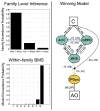Controlling automatic imitative tendencies: interactions between mirror neuron and cognitive control systems
- PMID: 23811412
- PMCID: PMC4004608
- DOI: 10.1016/j.neuroimage.2013.06.060
Controlling automatic imitative tendencies: interactions between mirror neuron and cognitive control systems
Abstract
Humans have an automatic tendency to imitate others. Although several regions commonly observed in social tasks have been shown to be involved in imitation control, there is little work exploring how these regions interact with one another. We used fMRI and dynamic causal modeling to identify imitation-specific control mechanisms and examine functional interactions between regions. Participants performed a pre-specified action (lifting their index or middle finger) in response to videos depicting the same two actions (biological cues) or dots moving with similar trajectories (non-biological cues). On congruent trials, the stimulus and response were similar (e.g. index finger response to index finger or left side dot stimulus), while on incongruent trials the stimulus and response were dissimilar (e.g. index finger response to middle finger or right side dot stimulus). Reaction times were slower on incongruent compared to congruent trials for both biological and non-biological stimuli, replicating previous findings that suggest the automatic imitative or spatially compatible (congruent) response must be controlled on incongruent trials. Neural correlates of the congruency effects were different depending on the cue type. The medial prefrontal cortex, anterior cingulate, inferior frontal gyrus pars opercularis (IFGpo) and the left anterior insula were involved specifically in controlling imitation. In addition, the IFGpo was also more active for biological compared to non-biological stimuli, suggesting that the region represents the frontal node of the human mirror neuron system (MNS). Effective connectivity analysis exploring the interactions between these regions, suggests a role for the mPFC and ACC in imitative conflict detection and the anterior insula in conflict resolution processes, which may occur through interactions with the frontal node of the MNS. We suggest an extension of the previous models of imitation control involving interactions between imitation-specific and general cognitive control mechanisms.
Keywords: Automatic imitation; Cognitive control; Dynamic causal modeling; Mirror neuron system; Spatial compatibility; fMRI.
© 2013.
Figures





Similar articles
-
How frontoparietal brain regions mediate imitative and complementary actions: an FMRI study.PLoS One. 2011;6(10):e26945. doi: 10.1371/journal.pone.0026945. Epub 2011 Oct 28. PLoS One. 2011. PMID: 22046422 Free PMC article.
-
Fronto-parietal mirror neuron system modeling: Visuospatial transformations support imitation learning independently of imitator perspective.Hum Mov Sci. 2019 Jun;65:S0167-9457(17)30942-9. doi: 10.1016/j.humov.2018.05.013. Epub 2018 Sep 12. Hum Mov Sci. 2019. PMID: 30219273
-
Do simple intransitive finger movements consistently activate frontoparietal mirror neuron areas in humans?Neuroimage. 2007;36 Suppl 2:T44-53. doi: 10.1016/j.neuroimage.2007.03.028. Epub 2007 Mar 30. Neuroimage. 2007. PMID: 17499169
-
Is the mirror neuron system involved in imitation? A short review and meta-analysis.Neurosci Biobehav Rev. 2009 Jul;33(7):975-80. doi: 10.1016/j.neubiorev.2009.03.010. Epub 2009 Apr 1. Neurosci Biobehav Rev. 2009. PMID: 19580913 Review.
-
The shared neural basis of empathy and facial imitation accuracy.Neuroimage. 2014 Jan 1;84:367-75. doi: 10.1016/j.neuroimage.2013.08.061. Epub 2013 Sep 3. Neuroimage. 2014. PMID: 24012546 Review.
Cited by
-
A neural signature for combined action observation and motor imagery? An fNIRS study into prefrontal activation, automatic imitation, and self-other perceptions.Brain Behav. 2022 Feb;12(2):e2407. doi: 10.1002/brb3.2407. Epub 2022 Jan 7. Brain Behav. 2022. PMID: 34994997 Free PMC article.
-
Complementary actions.Front Psychol. 2015 May 1;6:557. doi: 10.3389/fpsyg.2015.00557. eCollection 2015. Front Psychol. 2015. PMID: 25983717 Free PMC article. Review.
-
The inhibition of motor contagion induced by action observation.PLoS One. 2018 Oct 17;13(10):e0205725. doi: 10.1371/journal.pone.0205725. eCollection 2018. PLoS One. 2018. PMID: 30332470 Free PMC article.
-
Greater involvement of action simulation mechanisms in emotional vs cognitive empathy.Soc Cogn Affect Neurosci. 2018 Apr 1;13(4):367-380. doi: 10.1093/scan/nsy013. Soc Cogn Affect Neurosci. 2018. PMID: 29462481 Free PMC article.
-
Neural systems for preparatory control of imitation.Philos Trans R Soc Lond B Biol Sci. 2014 Apr 28;369(1644):20130176. doi: 10.1098/rstb.2013.0176. Print 2014. Philos Trans R Soc Lond B Biol Sci. 2014. PMID: 24778373 Free PMC article.
References
-
- Aicken MD, Wilson AD, Williams JH, Mon-Williams M. Methodological issues in measures of imitative reaction times. Brain Cogn. 2007;63:304–308. - PubMed
-
- Amodio DM, Frith CD. Meeting of minds: The medial frontal cortex and social cognition. Nat Rev Neurosci. 2006;7:268–277. - PubMed
-
- Augustine JR. Circuitry and functional aspects of the insular lobe in primates including humans. Brain Res Brain Res Rev. 1996;22:229–244. - PubMed
-
- Avenanti A, Bolognini N, Maravita A, Aglioti SM. Somatic and motor components of action simulation. Curr Biol. 2007;17:2129–2135. - PubMed
-
- Baldissera F, Cavallari P, Craighero L, Fadiga L. Modulation of spinal excitability during observation of hand actions in humans. Eur J Neurosci. 2001;13:190–194. - PubMed
Publication types
MeSH terms
Grants and funding
LinkOut - more resources
Full Text Sources
Other Literature Sources
Miscellaneous

